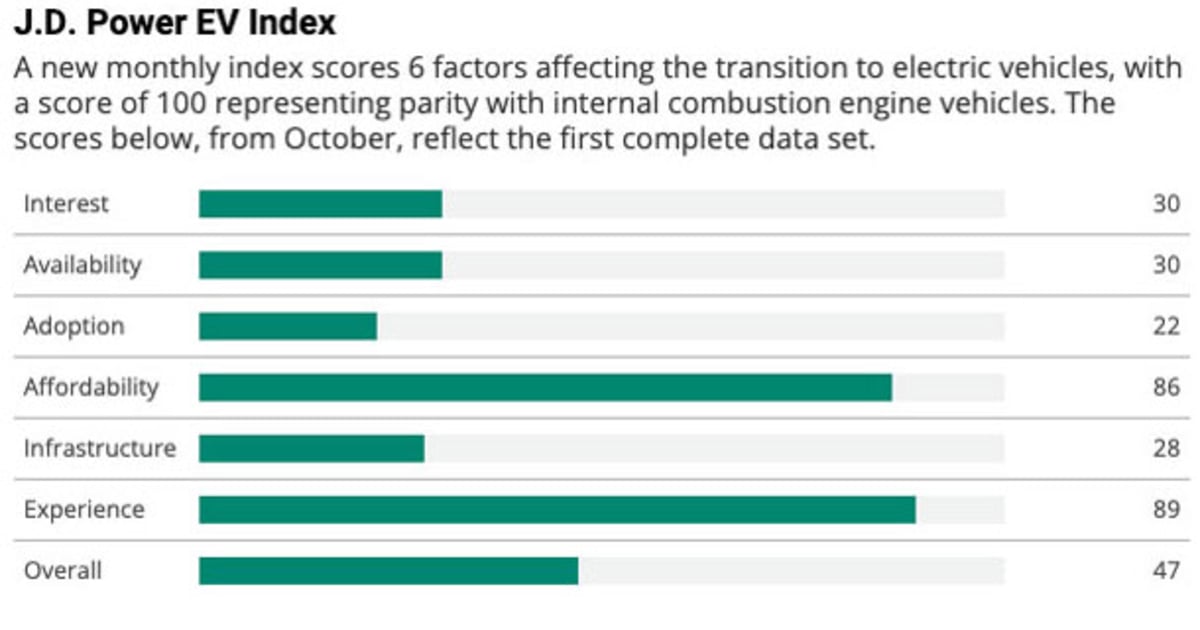
DETROIT — Electric vehicles nearly match internal combustion vehicles in cost of ownership and the ownership experience, according to a new J.D. Power index gauging the industry’s shift to EVs.
But wide gaps in four of the six categories measured — including charging infrastructure and consumer interest in EVs — show there is still a long way to go before the two forms of propulsion are on equal footing.
The J.D. Power EV Index, which launches Jan. 17, underscores a dichotomy in the transition to fully electric powertrains, even as global automakers plow billions of dollars into the rollout.
On one hand, U.S. customers who buy EVs rarely go back to internal combustion engine vehicles, and most find today’s battery-powered cars affordable when considering the cost to drive and maintain them as well as their resale value.
On the flip side, rising EV adoption ironically creates bigger infrastructure headaches. That’s because charging networks aren’t keeping up with vehicle sales, frustrating drivers who can’t locate a station or who find one occupied or broken. Meanwhile, the EV adoption rate, which measures the percentage of people who choose an EV when there’s a viable option, has been declining because availability is increasing faster than sales.
“The EV marketplace is new, complex and dynamic, and most importantly, there are interdependencies that affect true adoption during the transition from ICE to EV,” Elizabeth Krear, J.D. Power’s vice president of EV practice, told Automotive News last week. “Having the ability to keep a pulse on all these interdependencies is critical.”
Several infrastructure deals have highlighted the rapidly changing EV landscape.
The California Energy Commission last week approved a $2.9 billion investment plan to accelerate the state’s 2025 EV charging and hydrogen refueling goals. The investment will fund 90,000 new chargers across the state.
Meanwhile, at the federal level, last year’s $1 trillion infrastructure bill provides $5 billion to help states install chargers along interstate highways over five years. In September, the U.S. Transportation Department approved the charging station plans for all 50 states; Washington, D.C.; and Puerto Rico, covering about 75,000 miles of highways.
J.D. Power says its new study, which will be updated and released monthly, tracks the progress of the EV shift by looking at millions of data points across 26 data sets.
It measures EVs against their internal combustion counterparts on a scale of 0 to 100 in six categories: interest, availability, adoption, affordability, infrastructure and experience.
A score of 100 means EVs have achieved parity with gasoline-powered cars. The top-line score, which averages the results in each category, was 47 in October, which represented the first complete data set. When the index launches in January, it will reflect November data.
In October, owner experience scored highest, at 89, followed closely by affordability, at 86. But no other category was higher than 30. Infrastructure registered at 28, while adoption languished at 22.
When considering the total cost of ownership over five years, EVs are nearly even with equivalent gasoline offerings, and some models are cheaper, J.D. Power said. While EVs have higher sticker prices, electricity generally costs much less than gasoline, and EVs have higher residual values. EVs should climb closer to parity as federal tax credits become available in the coming years, J.D. Power predicted.
EVs also scored high in customer experience, with the Mercedes-Benz EQS and Tesla Model Y topping the premium segment, and the Kia EV6 ranking No. 1 among mass-market brands.
“Once they own an EV, customers just fall in love with how quiet it is, the smoothness of the ride and the torque off the line,” Krear said. Range limitations, however, remain a customer gripe.
Infrastructure support has been one factor getting worse, J.D. Power says. As more people buy EVs, it puts greater stress on charging stations, which can be unreliable and often aren’t monitored as closely as gasoline pumps. J.D. Power says more than 20 percent of EV drivers have been unable to use a public charger because of poor maintenance, software glitches or equipment damage.
Only two of the top 10 states for charging infrastructure, California and New York, are also among the top 10 states for pickup sales, J.D. Power notes. Texas, the top pickup state, had one of the lowest charging infrastructure scores. That portends frustration for early adopters of electric pickups, including the Ford F-150 Lightning and upcoming Chevrolet Silverado EV and GMC Sierra EV, it said.
Despite potential difficulties for buyers in some areas, J.D. Power forecasts that EV market penetration will rise rapidly through 2025. It predicts the retail market share of EVs will quadruple to roughly 1 in 5 vehicles by mid-decade from 1 in 20 this year.